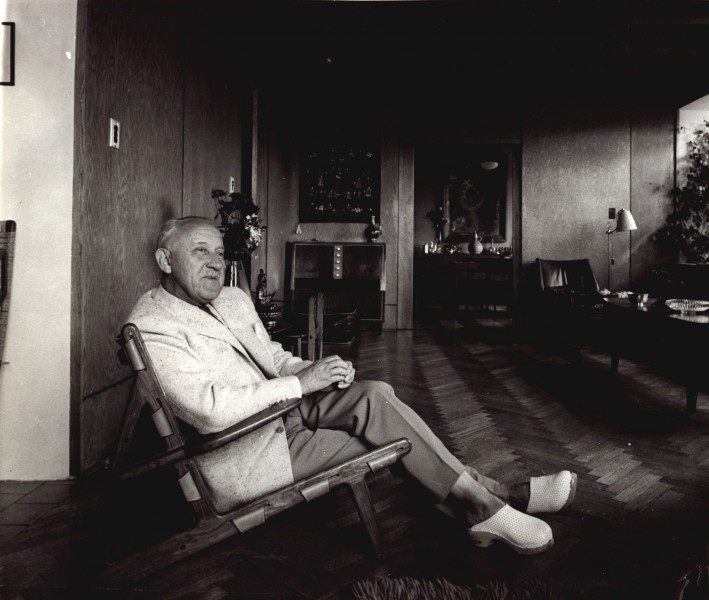Gljúfrasteinn was the home and workplace of Mr. Halldór Laxness, a Nobel Laureate in Literature in 1955. The house was a home of Halldór Laxness his wife Auður and their children for more than half a century. Their home is mostly unchanged since they lived there and has been a public museum since 2004.
Virtual tour

Halldór situr í Veiðistólnum, "Hunting chair" eftir danska hönnuðinn Børge Mogensen.
In April 2020, a virtual tour of the Laxness Museum was produced due to restrictions because of the COVID-19 pandemic as the museum was not able to secure two meter social distancing rule for guests. Through the virtual tour, visitors can navigate between the rooms and access the art collection. Accompanied by the Hamrahlíð choir singing Hjá lygnri móðu in the background, a poem by Halldór Laxness.
Halldór Laxness’ life span most of the 20th century. He was born in 1902 and died 96 years of age in 1998. His life and work reflect the cultural, political, and intellectual movements that shooked and transformed the world in his time. His career spanned an incredibly long period from 1919-1987. Throughout this time - almost 70 years - he remained prominent both in Icelandic national life and on the European cultural stage. He produced 62 works in 68 years, that is, nearly a book a year.
Laxness´s house was built in 1945, designed by the Icelandic architect, Ágúst Pálsson. The house is located in the country side, just within 20 minutes drive from Reykjavík, and is close to the author’s childhood home at the farmstead, Laxnes. As Halldór was busy writing (as usual) his wife Auður Laxness supervised the construction of the house. Birta Fróðadóttir designed the interior, Auður´s father Sveinn Guðmundsson renovated the candelabra in the sitting room and made several wall lamps for the home. The house is filled with remarkable paintings, mostly by Icelandic painters and who were also friends of the family. Such as Kjarval, Svavar Guðnason, Nína Tryggvadóttir, Louisa Matthíasdóttir and many others. The house’s lounge is characterized by the strong light from the southern window, the grand piano and Auður’s tapestry that echo´s the abstract paintings in the house. The walls radiate warmth of the house’s history and household life, like the crowded concerts and dinner parties, enjoyed by many visitors in their days.